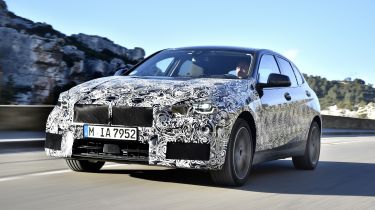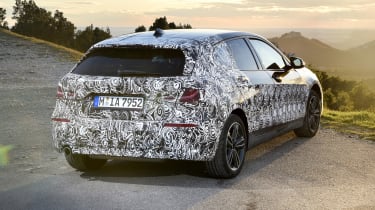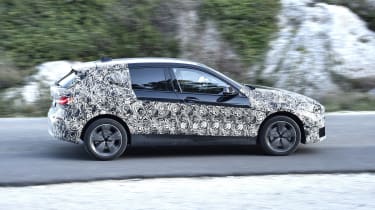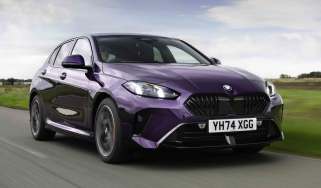2019 BMW 1 Series pre-production review
We get behind the wheel of the new, front-wheel-drive BMW 1 Series ahead of its full release
The next BMW 1 Series will be front-wheel drive for the first time, and we’ve driven a prototype version before its launch later in 2019. While the move from rear-drive to front-drive has upset some BMW enthusiasts, the manufacturer points out that the change benefits everything from interior and boot space to fuel economy. Most buyers will struggle to tell the difference, anyway.
It’s not the first BMW to send its power to the front wheels, as the company also sells the 2 Series Active Tourer and Gran Tourer MPVs. These are sold in tiny numbers compared to the 1 Series, though, so the first use of front-wheel drive on a more mainstream model is a major change for the company.
Best luxury small cars you can buy
The next-generation BMW 1 Series will be revealed before the end of the year, with sales starting soon after. This front-wheel-drive platform will also underpin the new BMW 2 Series, which will be offered as a four-door Gran Coupe variant for the first time.
2019 BMW 1 Series styling
The prototype 1 Series models we rode in were heavily camouflaged but they matched the look of cars seen in previous spy shots. It appears that the baby BMW will borrow some styling details from the new BMW 3 Series, with a larger grille, long bonnet and LED lights front and rear - these are set to be included on most, if not all, models. The headlights continue to be large, but their shape has been changed for a slightly sleeker design.
The range will include entry-level SE models, mid-range Sport and more expensive M Sport versions, which feature suspension and styling changes. BMW 1 Series M Sport models will sit lower and will feature larger alloy wheels, a boot spoiler and dual exhaust tips, and it’s likely that you’ll be able to tick boxes for sporty styling packs, blue brake calipers and more.
Interior
It’s only 10mm longer and 5mm taller than the outgoing model, but the new 1 Series feels noticeably bigger - in a good way. Rear-seat space is much more generous, and doesn’t feel anywhere near as cramped. Adults should have no problem getting comfy in the back on long journeys, thanks to 20mm increases in knee and headroom.
Without the mechanicals needed to facilitate rear-wheel drive, boot space is also improved by 20 litres. Now at 380 litres, it matches the Volkswagen Golf, SEAT Leon and Ford Focus, even if it’s still far behind the most spacious cars in the class.
The interior of our test car was heavily disguised so it’s hard to report on the finer details at this stage. We expect the inside of the new 1 Series to follow very closely from the new 3 Series in terms of both design and technology, with a 12.3-inch digital instrument cluster and a 10.25-inch central touchscreen likely. You’ll be able to control the latter with a dial on the centre console, by voice commands and possibly by gestures on higher-spec models.
Engines and performance
We mainly drove the 118i petrol, which is expected to be the biggest seller. It uses a familiar 1.5-litre turbocharged three-cylinder engine with 138bhp. No performance figures have been revealed, but expect 0-62mph to be dealt with in around 8.5 seconds, which will be quick enough for the majority of buyers.
The 118i, linked to a seven-speed dual-clutch automatic gearbox, offers smooth and strong performance with enough torque spread across the rev range. We found the gearbox to be slightly jerky and hesitant, although this should be improved before the car goes into production.
Across the range, the new 1 Series is around 20-25kg lighter than the current car. This is another benefit of switching to front-wheel drive, and should mean that the new model is slightly more economical. Four-wheel drive will also be offered on selected versions.
The 118i will be joined by more powerful 120i and 125i models, with a flagship M135i version due at a later date offering over 350bhp. Diesel engines will include a punchy 120d, expected to scoop up plenty of sales, and a 125d that’ll offer almost hot hatch-like performance as well as reasonable running costs. It’s currently not known whether an entry-level 116d version will kick off the range as it does in the outgoing car. Hybrid and electric versions are also due at a later date, with the former using the 1.5-litre petrol engine and an electric motor.
Driving and handling
BMW’s engineers are only going to make subtle tweaks to the pre-production models for the final production versions, so our test car should be representative of the car you’ll be able to buy. First impressions are very good: the car drives like you’d expect a BMW to, even if it isn’t rear-wheel drive any more.
The wheels are slightly further apart across the axles, and the body is stiffer than before. These changes help to create a car that’s more agile than its predecessor, while steering response and ride quality have both been improved too. The mechanical and electrical components feel seamlessly connected to each other, creating a driving experience that’s harmonious, responsive and well controlled.
The standard chassis prioritises comfort, and is excellent on most road surfaces until you get up to high speeds. We also briefly tested a 120d model with an optional Sport setup, which highlighted more imperfections in the road surface but was never uncomfortable or crashy. It was certainly firmer, with less body roll and increased agility. If you want a sportier-feeling 1 Series, you don’t have to compromise too much on the ride quality. A new stability system aims to make the car fun and a new steering rack is designed to aid responsiveness by reducing friction.
The company has also fitted a traction control system that’s similar to the one in the BMW i3. It’s partly integrated into the ECU (the car’s computer brain) to make it up to ten times quicker to react. Yes, the switch from rear- to front-wheel drive has changed the dynamics of the car, and enthusiasts may notice the difference, but most buyers will simply appreciate that it’s nice to drive and rides well.
Verdict
An awful lot of work has gone into making the first big-selling front-wheel drive BMW a success, and you can tell. Considering the benefits of improved passenger space, a bigger boot, lighter weight and better agility, it’s unsurprising that BMW has chosen to ditch rear-wheel drive for the new 1 Series. A great driving experience is still one of the main plus points of this car, and its interior will surely be better than ever, so the BMW 1 Series is set to continue as one of the benchmarks in the hatchback class.
Recommended
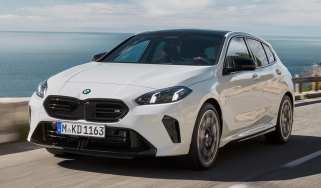
New BMW 1 Series: hybrid tech but no diesel for facelifted baby Beemer
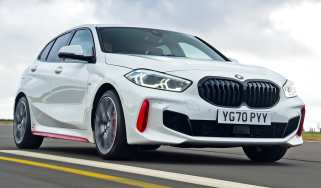
Hot car deal: Fun-focused BMW 128ti hot hatch for £309 a month
Most Popular

Suzuki’s new 10-year warranty is free – here’s how to get it
Tips & advice

Car dashboard warning lights: what does each symbol mean?

Electric car charging stations: public networks, charger types, apps and maps


